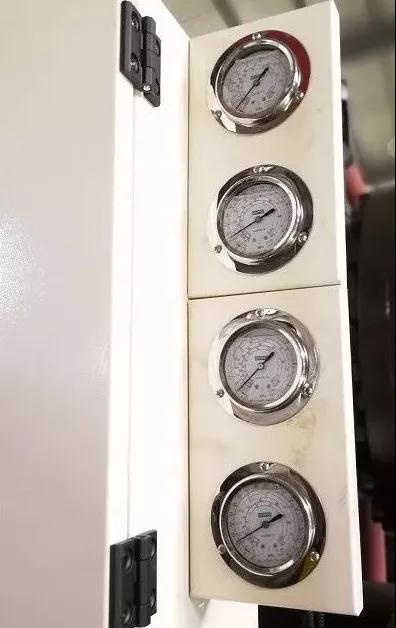Stepping into October, as the cold air strikes, the temperature gradually declines. In the fall and winter seasons when the temperature is lowered, people need to dress and protect, and your chiller needs careful maintenance to ensure normal operation.
Below, Xiaobian will share with you the relevant precautions and methods for the maintenance of chillers in autumn and winter:
01
The chiller antifreeze has a coup
Antifreeze of main engine and water pump
When the winter temperature in the main room is lower than 0 °C, antifreeze measures should be taken for the main engine, chilled water pump and cooling water pump.
(1) Antifreeze of the main machine: Close the main condenser and evaporator inlet and outlet valves, open the drain valve and the vent valve, and then use compressed air to blow off the remaining water.
(2) Antifreeze of the pump: The chilled water pump inlet and outlet valves are closed, the water pump drain valve and the vent valve are opened, and the water is drained. Open the lowest point valve of the cooling water system, drain the cooling water, and open the water pump drain valve. After the system water is drained, in order to prevent rainwater from entering through the cooling tower, close the cooling tower water outlet main valve and open the cooling tower water collection drain valve. So that the rainwater is drained from the drain valve in time.

▲ SUNNY-HVAC chiller
Antifreeze of cooling tower water supply pipe
In general, the cooling tower water supply pipes are exposed to the outdoors, and most of them are anti-freezing by the heat preservation method. However, in actual use, even if the heat preservation is performed, the freezing phenomenon often occurs. In order to solve this problem, when the cooling tower water supply pipe is taken out from the room, a valve is added, and a drain valve is added at the lowest point of the water supply pipe. When the winter comes, close the valve in the room and open the lowest point drain valve to drain the water in the outdoor tube so that the pipe does not need to be insulated and will not be cracked.
Antifreeze during long holidays
During the holiday period, the ambient temperature is low, and some parts of the water system may be below 0 °C for a long time, there is a possibility of being damaged by freezing. The manager is required to turn on the water pump according to the actual situation and raise the temperature of the water in the system, so the management staff should respond. The entire central air-conditioning system is fully understood, and the vulnerable parts are identified, and precautions are taken in advance to ensure that the water system is not frozen.
Antifreeze at an ambient temperature below 0 °C

If the ambient temperature is below 0 °C, it is recommended that the user add antifreeze to the cooling tower or water tank (adjust the antifreeze concentration ratio according to the local ambient temperature).
02
Daily inspection and maintenance
1) Remove the garbage and debris during installation and repair, and keep the environment of the equipment room and the surrounding area of the unit clean;
2) Remove dust and dirt exposed to the pipeline to detect leaks and repairs in a timely manner;
3) Check whether the heat-insulating materials of the heat exchanger and the pipeline are in good condition. If it is found to be damaged or peeled off, it should be repaired in time;
4) Check the fasteners of the unit for looseness, properly tighten the fasteners, eliminate vibration and prevent leakage;
5) Check whether the line voltage of the unit power supply and the imbalance of each phase voltage are within the specified range;
6) Record the operating data of the unit: unit voltage, current, high and low pressure gauge pressure, freezing inlet and outlet water temperature, cooling water inlet and outlet water temperature, compressor exhaust temperature, etc.;
7) Check the drying filter. If frosting is found at this position, the filter is blocked and the filter element needs to be replaced.

▲ filter
8) Check if the oil level of the compressor is normal;
9) Check the moisture indication of the sight glass. If yellow is displayed, replace the dry filter core.
10) Apply butter to the valve stem of each valve of the equipment and a few drops of oil on the door hinge and door lock of the control cabinet to avoid rusting and biting of the moving parts;
11) Check if the screws of each device are loose;
12) Check if the pipe joints leak;
13) Check whether the wires are worn, whether the connection is firm, and whether the contacts are burnt or not; (to prevent the injury caused by electric shock or contact with moving parts, the isolation switch of the locking unit is in the disengaged state)
14) Clean all water filters of the freezing and cooling water system;
15) Check whether the freezing and cooling water systems are exposed to air;
16) Check if the refrigerant pressure is normal;
17) The surface of the condenser is cleaned and descaled;
18) Check if the expansion tank and make-up water are normal;
19) Check if the pressure indicated by the high and low pressure gauge of the unit is normal;

▲ pressure gauge
20) Check the temperature difference between the inlet and outlet sections of the dry filter when the unit is running at full load;
21) Analyze the compressor oil in the laboratory to check the water content and acidity of the refrigerant system. When the pH is lower than 6, the compressor oil must be replaced in time. If the conditions for checking the acidity are not met, the dry filter core of the refrigerant system should be replaced regularly to keep the system dry.
22) Tighten all the wire connectors in the control box and the starter cabinet; (to prevent the injury caused by electric shock or contact with moving parts, the disconnecting switch of the locking unit is in the disengaged state)
23) Detect any refrigerant leakage at all connections;
24) Test the evaporator and condenser tube bundles every three years using non-destructive testing of the pipeline; (Note: For the use of chillers, it may be better to shorten the cycle of these tube bundles accordingly, especially for some important applications. Unit)
25) Generally, the lubricating oil must be inspected or replaced every 5000 to 10,000 hours of operation. After the first operation, it is recommended to replace the lubricating oil and clean the oil filter and the compressor suction filter for 2000 to 2500 hours. Because the residue of the system assembly will accumulate in the compressor after the official operation, the lubricant should be replaced once in 2500 hours or 3 months, and then replaced according to the cleanliness of the system. If the system is clean, it can be used every 10,000 hours ( Or replace it once a year. If the exhaust temperature of the compressor is maintained at a high temperature for a long period of time, the deterioration rate of the lubricating oil is fast, and the degree of deterioration of the lubricating oil needs to be checked according to the cycle recommended in the following table;

(Note: In the case of a compressor with a compressor burned in the previous case, after replacing the compressor, the unit should be operated for 24-48 hours to replace 1-3 times of refrigerating oil, and the lubricating oil condition or timing should be tracked every month (200 hours recommended) Replace the lubricant until the system is clean, otherwise the compressor may burn again)
26) According to the application of the unit, contact the company or a suitable maintenance company to conduct a comprehensive inspection at the agreed time.
03
Fall and winter maintenance should be kept in mind
First of all
1. Turn off the water source of the chiller, and clean the water inside the unit parts and the pipeline, avoiding the residual water rusting unit parts after the shutdown, or the frost-expanded copper tube with too low temperature;
2. Turn off the power and check each component for wear (some need to be replaced);
3. Clean the fan of the air-cooled chiller and keep it in a clean state;
4. There is also a water tank of the water tank coil evaporator to check whether there is dirt and other debris and to remove it;
5. Know the use of lubricating oil through data recording, and regularly change the lubricating oil according to the use standard to maintain a good lubrication state.
Second
After the machine is shut down, the surface of the unit can be cleaned with a cleaning tool. When it is dry, cover the unit with a cloth or a smock to prevent dust and other debris from adhering to the unit, and ensure that it is clean when used in the coming year. The chiller.
The human body needs maintenance and regular physical examination, and the machinery and equipment are also the same. Only the care and maintenance work can better guarantee its performance and use time. The chiller is no exception!

Industrial refrigeration, chiller, Water-cooled screw chiller, industrial chiller, screw chiller, air-cooled chiller, buy products on the Shanghai Shangyu Refrigeration Equipment Co., Ltd., the company is a refrigeration equipment research and development, design, production, sales And high-tech enterprises, such as installation.
At present, Shanghai SUNNY-HVAC's Water-cooled screw chiller, industrial refrigeration, chillers, chillers, Water-cooled screw chiller, screw chillers, and air-cooled chillers have been widely used in chemical, chemical fiber, plastic, grease, food, Pharmaceuticals, military industry, printing, coating, electroplating, electronics and other industries provide high-speed development of China's industry with efficiency and quality assurance.






